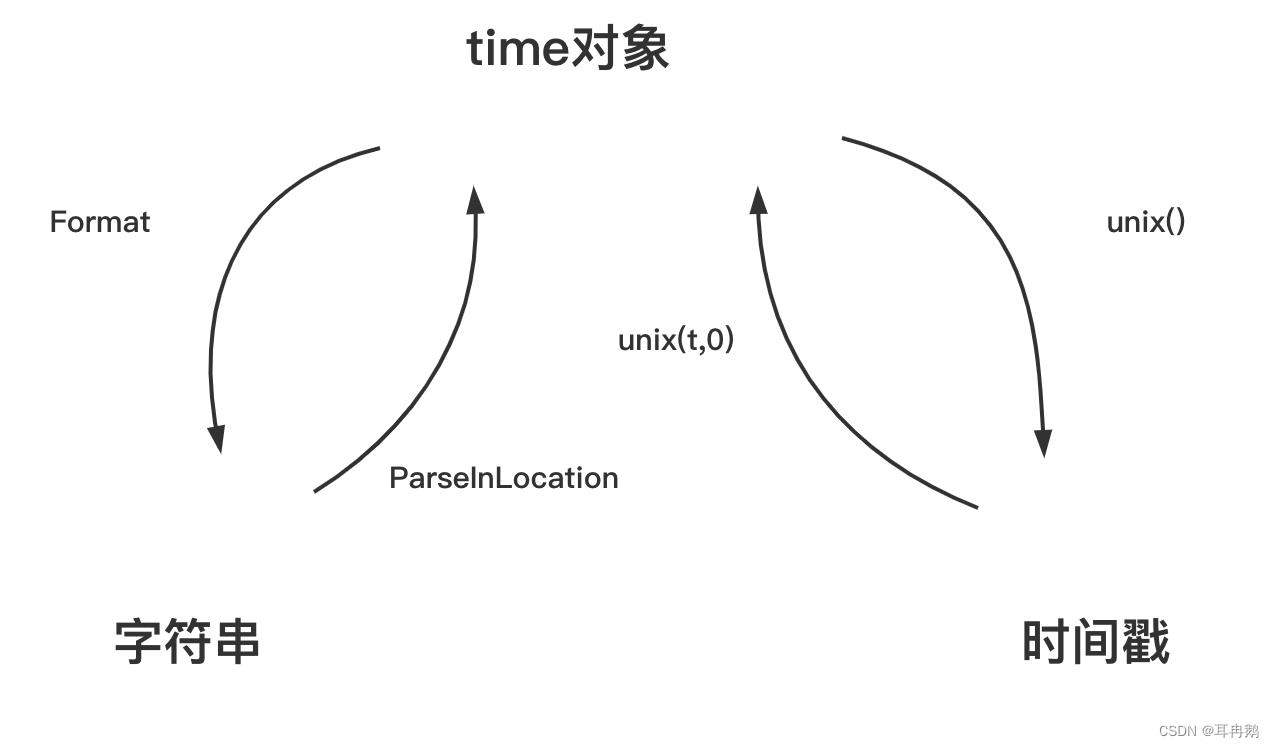Golang标准包time总结
Posted 耳冉鹅
tags:
篇首语:本文由小常识网(cha138.com)小编为大家整理,主要介绍了Golang标准包time总结相关的知识,希望对你有一定的参考价值。
时间
标准包Time
Golang的time标准包
type Time struct
// wall and ext encode the wall time seconds, wall time nanoseconds,
// and optional monotonic clock reading in nanoseconds.
//
// From high to low bit position, wall encodes a 1-bit flag (hasMonotonic),
// a 33-bit seconds field, and a 30-bit wall time nanoseconds field.
// The nanoseconds field is in the range \\[0, 999999999\\].
// If the hasMonotonic bit is 0, then the 33-bit field must be zero
// and the full signed 64-bit wall seconds since Jan 1 year 1 is stored in ext.
// If the hasMonotonic bit is 1, then the 33-bit field holds a 33-bit
// unsigned wall seconds since Jan 1 year 1885, and ext holds a
// signed 64-bit monotonic clock reading, nanoseconds since process start.
wall uint64
ext int64
// loc specifies the Location that should be used to
// determine the minute, hour, month, day, and year
// that correspond to this Time.
// The nil location means UTC.
// All UTC times are represented with loc==nil, never loc==&utcLoc.
loc \\*Location
Time结构的官方解释:Time结构代表具有纳秒精度的瞬间
程序在存储和传递Time时应该实用值(t Time)而不是指针(t *Time),即Time类型的变量和结构字段的类型应为time.Time,而不是time.Time
可以看到三个属性

Go语言出生时便使用uint64,因此全部用于表示时间时则会是一个非常大的时间:
package main
import "time"
const UINT64_MIN uint64 = 0
const UINT64_MAX uint64 = ^uint64(0)
const form = "2006-01-02 15:04:05"
func main()
t, _ := time.Parse(form, "9999-12-31 23:59:59")
println("unint64 的最大值为:", UINT64_MAX)
println("9999-12-31 23:59:59 的时间戳为:", t.Unix())
结果:
unint64 的最大值为: 18446744073709551615
9999-12-31 23:59:59 的时间戳为: 253402300799
因此wall(64位)中的某些位可以拿来做其他事情,比如标识是否包含monotonic clocks等。
实际上Time结构也正是如此,官方文档:
// wall and ext encode the wall time seconds, wall time nanoseconds,
// and optional monotonic clock reading in nanoseconds.
//
// From high to low bit position, wall encodes a 1-bit flag (hasMonotonic),
// a 33-bit seconds field, and a 30-bit wall time nanoseconds field.
// The nanoseconds field is in the range [0, 999999999].
// If the hasMonotonic bit is 0, then the 33-bit field must be zero
// and the full signed 64-bit wall seconds since Jan 1 year 1 is stored in ext.
// If the hasMonotonic bit is 1, then the 33-bit field holds a 33-bit
// unsigned wall seconds since Jan 1 year 1885, and ext holds a
// signed 64-bit monotonic clock reading, nanoseconds since process start.
wall和ext两个属性分别用于编码wall time中的总秒数和wall time中的纳秒数,还可能包含了可选的monotonic clock的纳秒格式的读数- 从高位到低位,wall 编码时,第一个位(1-bit)是一个标识符位,用于标识是否包含了monotonic clock。可以将wall与
hasMonotonic做位与(&)运算来检查
hasMonotonic定义: hasMonotonic = 1 << 63
- 接下来的33位和最后的30位,分别用于编码wall time的总秒数和纳秒数, 纳秒数取值范围:[0,999999999]
- 如果hasMonotonic位取值为0,则中间的33位会被设置为且必须为
0, 然后会将自 1 年 1 月 1 日 0 时 0 分 0 纳秒的有符号的 wall clock 总秒数都存储在ext中。但是,纳秒数还是存储在原来的位置,也就是wall的剩余的 30 位 - 如果 hasMonotonic 位的取值为
1,那么中间的 33 位存储了自 1885 1 年 1 月 1 日 0 时 0 分 0 纳秒的以来的无符号的 wall clock 的总秒数,而ext则存储了有符号的 64 位的 monotonic clock 读数,也就是,进程创建以来的总纳秒数
至于loc这个属性, loc用于指定了用于确定与此时间对应的分、时、月、日、年的时区
如果loc值为null, 则表示UTC。 所有的UTC时间都用loc == nil 表示, 而不是 loc == &utcLoc
时间戳转换
package main
import (
"log"
"time"
)
func main()
t := int64(1546926630) //外部传入的时间戳(秒为单位),必须为int64类型
t1 := "2019-01-08 13:50:30" //t1的时间字符串
//时间转换的模板,golang里面只能是 "2006-01-02 15:04:05" (go的诞生时间)
timeTemplate1 := "2006-01-02 15:04:05" //常规类型
timeTemplate2 := "2006/01/02 15:04:05" //其他类型
timeTemplate3 := "2006-01-02" //其他类型
timeTemplate4 := "15:04:05" //其他类型
timeTemplate5 := "20060102150405" //其他类型
// ======= 将时间戳格式化为日期字符串 =======
log.Println(time.Unix(t, 0).Format(timeTemplate1)) //输出:2019-01-08 13:50:30
log.Println(time.Unix(t, 0).Format(timeTemplate2)) //输出:2019/01/08 13:50:30
log.Println(time.Unix(t, 0).Format(timeTemplate3)) //输出:2019-01-08
log.Println(time.Unix(t, 0).Format(timeTemplate4)) //输出:13:50:30
log.Println(time.Unix(t, 0).Format(timeTemplate5)) //输出:20190108135030
// ======= 将时间字符串转换为时间戳 =======
stamp, _ := time.ParseInLocation(timeTemplate1, t1, time.Local) //使用parseInLocation将字符串格式化返回本地时区时间
log.Println(stamp.Unix()) //输出:1546926630
获取想要的时间格式——string
// time对象
timeStr := time.Now().Format("2006-01-02")
println(timeStr) // 2022-09-18
// 时间戳
t := int64(1546926630)
println(time.Unix(t, 0).Format("2006-01-02")) //2019-01-08
获取想要的时间戳——int64
timeStr := time.Now().Format("2006-01-02")
t5, _ := time.ParseInLocation("2006-01-02", timeStr, time.Local)
timeUnix := t5.Unix()
println(timeUnix) // 1663430400

处理时间差
time常用方法
After(u Time) bool
时间类型比较,是否在Time之后
Before(u Time) bool
时间类型比较,是否在Time之前
Equal(u Time) bool
比较两个时间是否相等
IsZero() bool
判断时间是否为零值,如果sec和nsec两个属性都是0的话,则该时间类型为0
Date() (year int, month Month, day int)
返回年月日,三个参数
Year() int
返回年份
Month() Month
返回月份.是Month类型
Day() int
返回多少号
Weekday() Weekday
返回星期几,是Weekday类型
ISOWeek() (year, week int)
返回年份,和该填是在这年的第几周.
Clock() (hour, min, sec int)
返回小时,分钟,秒
Hour() int
返回小时
Minute() int
返回分钟
Second() int
返回秒数
Nanosecond() int
返回纳秒
// Add 时间相加
now := time.Now()
// ParseDuration parses a duration string.
// A duration string is a possibly signed sequence of decimal numbers,
// each with optional fraction and a unit suffix,
// such as "300ms", "-1.5h" or "2h45m".
// Valid time units are "ns", "us" (or "µs"), "ms", "s", "m", "h".
// 10分钟前
m, _ := time.ParseDuration("-1m")
m1 := now.Add(m)
fmt.Println(m1)
// 一天后
dd, _ := time.ParseDuration("24h")
dd1 := now.Add(dd)
fmt.Println(dd1)
// Sub 计算两个时间差
subM := now.Sub(m1)
fmt.Println(subM.Minutes(), "分钟")
sumD := now.Sub(dd1)
fmt.Printf("%v 天\\n", sumD.Hours()/24)
以上是关于Golang标准包time总结的主要内容,如果未能解决你的问题,请参考以下文章